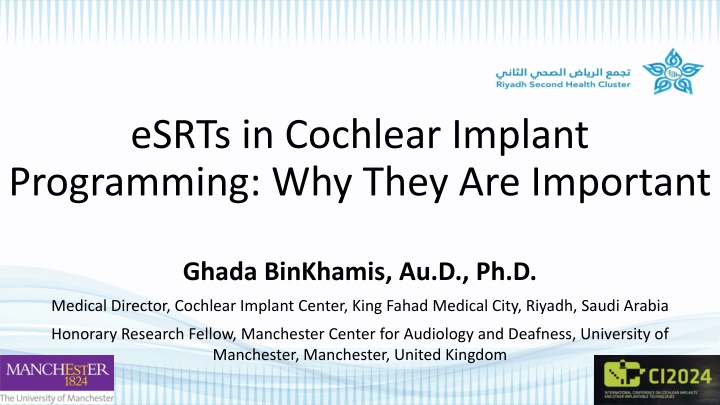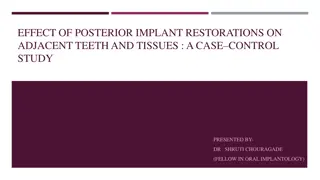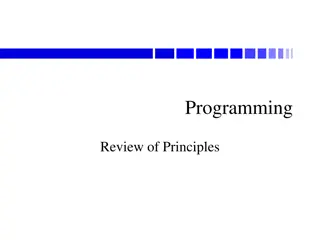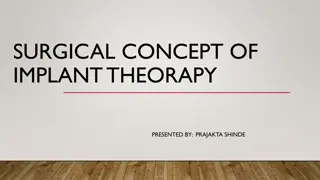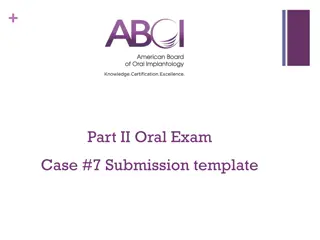Significance of eSRTs in Cochlear Implant Programming
The Electrical Stapedial Reflex Threshold (eSRT) plays a critical role in setting optimal stimulation levels for cochlear implants, ensuring balanced sound quality, speech recognition, and preventing overstimulation. eSRTs are a reliable predictor of stimulation levels, guiding the adjustment of settings for better speech production and monitoring capabilities in CI recipients.
Download Presentation

Please find below an Image/Link to download the presentation.
The content on the website is provided AS IS for your information and personal use only. It may not be sold, licensed, or shared on other websites without obtaining consent from the author.If you encounter any issues during the download, it is possible that the publisher has removed the file from their server.
You are allowed to download the files provided on this website for personal or commercial use, subject to the condition that they are used lawfully. All files are the property of their respective owners.
The content on the website is provided AS IS for your information and personal use only. It may not be sold, licensed, or shared on other websites without obtaining consent from the author.
E N D
Presentation Transcript
eSRTs in Cochlear Implant Programming: Why They Are Important Ghada BinKhamis, Au.D., Ph.D. Medical Director, Cochlear Implant Center, King Fahad Medical City, Riyadh, Saudi Arabia Honorary Research Fellow, Manchester Center for Audiology and Deafness, University of Manchester, Manchester, United Kingdom
Electrical Stapedial Reflexes Like acoustic stapedial reflexes but evoked by electrical stimulation through the cochlear implant (CI) instead of acoustic stimulation in the ear canal. The Electrical Stapedial Reflex Threshold (eSRT) is the lowest level where a repeatable reflex is elicited on two ascending trials.
Sound Processor CI Programming Computer Immittance CI Programming Interface Bridge (with Reflex Decay or eSRT Function)
The eSRT is THE ONLYobjective, electrophysiologic measure that is a good predictor of cochlear implant stimulation levels. Wolfe (2020)
eSRTs are an excellent predictor of upper stimulation levels. i.e., MCL, C, and M levels. e.g. Brickley et al. (2005), Buckler & Overstreet, (2003), Gordon et al. (2004), Hodges et al. (1997), Kosaner et al. (2009), Lorens, et al. (2004), Wolfe & Kasulis (2008)
Setting MAP upper stimulation levels based on eSRTs: Loudness balanced levels across the electrode array. Optimal sound quality and speech recognition. Ensures CI recipient is not overstimulated.
Appropriately set upper stimulation levels are VITAL for: Speech recognition. Sound quality. Ability to monitor own voice. Intelligible speech production.
Case 1 2-year-old child. Family reported that since last MAPping session: Voice became very loud. Became very inattentive and easily agitated.
eSRT Based MCLs eCAP MCLs Behavioral MCLs
Case 2: 18-month-old child. Global developmental delay. Activated/switched-on with eCAP based progressive MAPs.
Case 3 3-year-old child (past eCAP based MAPs). Bilateral CIs. Unintelligible speech. Facial twitch with moderate to loud sounds. No twitch when stimulating individual electrodes, only when live with both processors.
How you use ESRTs in the MAP Very Simple! (For contralaterally recorded eSRTs) MED-EL: Set MCLs 10% below the eSRT. Cochlear: Set C levels at 10 to 20 current levels below the eSRT. Advanced Bionics: Set M levels at 90% of the eSRT.
Want to learn how to record eSRTs? Come to my instructional course tomorrow morning (Hall 2 @ 8:00)
References Brickley, G., Boyd, P., Wyllie, F., O Driscoll, M., Webster, D., & Nopp, P. (2005). Investigations into electrically evoked stapedius reflex measures and subjective loudness percepts in the MED-EL COMBI 40+ cochlear implant. Cochlear Implants International, 6(1), 31 42. Buckler, L., & Overstreet, E. (2003). Relationship between electrical stapedial reflex thresholds and Hi-Res program settings: Potential tool for pediatric cochlear-implant fitting. Valencia, CA: Advanced Bionics. Feeney, M; Schairer K (2015) in Katz, J. Handbook of Clinical Audiology. Lippincott Williams and Wilkins. Kindle Edition. Gordon, K., Papsin, B. C., & Harrison, R. V. (2004). Programming cochlear implant stimulation levels in infants and children with a combination of objective measures. International Journal of Audiology, 43(Suppl. 1), S28 S32. Hodges, A. V., Balkany, T. J., Ruth, R. A., Lambert, P. R., Dolan-Ash, S., & Schloffman, J. J. (1997). Electrical middle ear muscle reflex: use in cochlear implant programming. Otolaryngology- Head and Neck Surgery, 117(3 Pt 1), 255 261. Hodges A. V., Butts S, King J. (2003) Electrically evoked stapedial reflexes: Utility in cochlear implant patients. In H. Cullington (Ed.), Cochlear implants objective measures (pp. 81 93). Philadelphia, PA: Whurr. Kosaner, J., Anderson, I., Turan, Z., & Deibl, M. (2009). The Use of ESRT in Fitting Children with Cochlear Implants. Journal of International Advanced Otology, 5(1). Lorens, A., Walkowiak, A., Piotrowska, A., Skarzynski, H., & Anderson, I. (2004). ESRT and MCL correlations in experienced paediatric cochlear implant users. Cochlear Implants International, 5(1), 28 37. Wolfe, J (2020). COCHLEAR IMPLANTS: Audiologic Management and Considerations for Implantable Hearing Devices. Plural Publishing Wolfe, J., & Kasulis, H. (2008). Relationships among objective measures and speech perception in adult users of the HiResolution Bionic Ear. Cochlear Implants International, 9(2), 70 81.
Thank You www.linkedin.com/in/ghada-binkhamis-aud-phd-ci-audiologist
